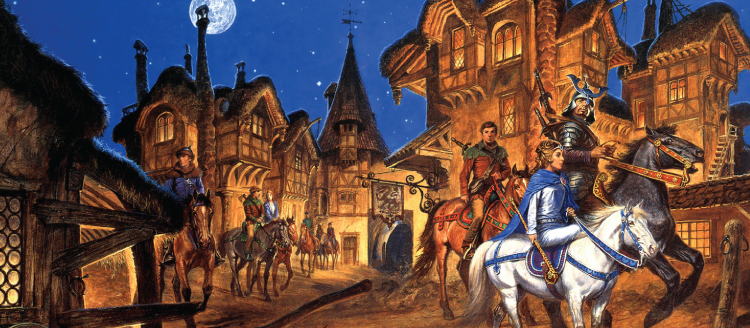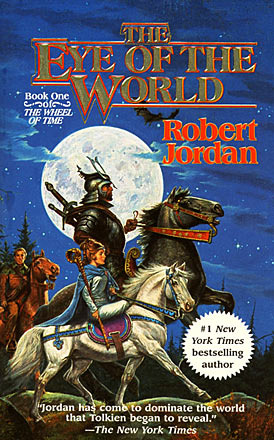

“Wood is soft compared to steel, but the sharp steel is dulled as it chops, and the sap of the tree will rust and pit it. The mighty axe does violence to the helpless tree, and is harmed by it. So it is with men, though the harm is in the spirit.”
Following in the footsteps of Terry Brooks’s endless Shannara series, Robert Jordan begins his epic fantasy series, The Wheel of Time, with an uninspired Tolkien derivative The Eye of the World. While it isn’t wrong to take inspiration from those who came before, it leaves a bad taste in my mouth to see authors repeating the same old stories, walking the reader through the same old tropes and cliches, and then expecting to earn critical acclaim because the fantasy world has many places and characters and historical events which somehow makes it epic.1 It’s undeniable that every writer is formed by the material they read and are drawn to, just as Tolkien was pulling inspiration from a plethora of ancient mythologies and fairy tales, as well as his Christian heritage. But Tolkien didn’t just emulate, he combined, experimented, and produced a unique and singular work with The Lord of the Rings. Unlike Tolkien, Jordan never had a wealth of background knowledge of history, language, art, and culture to truly develop anything organic and original, and so he fails to even mimic Tolkien to a convincing level, let alone produce something inspired yet original.
Jordan’s writing style takes superficially exciting encounters with the fantastical from the sword and sorcery genre and couples that with an insanely large word count (I can’t tell you how many times I was tempted to skim a paragraph because it started with a description of a dress or a serving tray or a sword hilt). It is unfortunate that he felt the need to take so many pages to tell such a simple and familiar story; but then again, a short book would not be “epic.”
The main character, Rand al’Thor, looks different from the other people in his village, and is unsure of his lineage. He and his friends, Mat and Perrin, are marked by the Dark One’s agents as potentially significant in some way. They are attacked by various creatures that are all vaguely linked to the Dark One and are all physically dark-colored. He is given a mysterious sword by his “father,” the markings on it signifying that its bearer is a master swordsman.
When the boys’ village, Emond’s Field, is attacked by Trollocs, the three companions flee with an Aes Sedai and a Warder, named Moiraine and Lan, respectively. The mysterious duo’s abilities are great but mostly unknown, with new ones introduced when convenient—healing powers, incredible reflexes, shooting fireballs from hands, etc. Rand’s romantic interest, Egwene, also comes along. She discovers that she, along with the boys, is somehow wrapped up in this plot, as she is able to touch the power of the universe, the same power that is somehow controlling the fate of everyone. But, some people can change their fate with a strong enough will.
Coming in and out of the story at various points are a peddler named Padan Fain, and a gleeman named Thom Merrilin, who appears to be more significant then initially suggested. Rand also meets Queen Morgase and her children, Elayne and Gawyn, when he falls into their courtyard while trying to get a view of the False Dragon Logaine as he is wheeled through the city streets in a military procession. There are various factions—Children of Light, The Traveling People (called “Tinkers”)—that the characters encounter, as well mysterious individuals such as a wolfman named Elyas, The Green Man (basically Treebeard from Lord of the Rings), and an Ogier named Loial who allows them to travel through The Ways (kind of like wormholes).
So the plot and stock characters are not really anything new. It doesn’t completely rip off another plot in quite the way that Christopher Paolini did with Eragon, where he lifted the plot of Star Wars and dressed it up like Lord of the Rings and called it a day,2. However, it feels as if Jordan thought people wanted to read a watered down Lord of the Rings without any original contributions to the genre, whether that be storytelling method, plot devices, or concepts.3 A sense of nostalgia simply cannot carry a book of this length.
It is obvious that the length is purposeful, as Jordan is trying to create a massive world that can be very popular (see George R. R. Martin’s A Song of Ice and Fire, or Steven Erickson’s Malazan Book of the Fallen). However, the details with which he populates the world are just fluff (at least for now). We get long extraneous monologues about battles and kings and enemies and lots of capitalized Names that mean nothing to us. If these asides could engage the reader, compelling us to burn through pages to learn more about these briefly mentioned historical moments, then they might work,4 but they don’t really do anything. The characters we follow throughout are unaffected by all of this irrelevant information fed to them, so it is hard to care (and so if it does come up later in the series, I probably won’t remember reading about it). If all of these facts will be pertinent later, then they should have been integrated into the story in such a way that the characters reacted in some way to learning them.
The characters are stock, the writing is workmanlike, the dialogue is plain, and the plot plodding and linear. It doesn’t do anything new, but it’s fine as a lengthy retread of the same old ideas.
1. Some, of course, don’t care about the critical reaction to their work, and just write what’s popular in hope that audiences will fork over enough money to allow them to keep writing books. I suppose writing haphazard epic fantasy is better than a lot of things people do for money.
2. To Paolini’s credit, Eragon was published when he was eighteen years old; Jordan was 42 when The Eye of the World came out.
3. The idea of ‘The Wheel of Time’ is not really unique to Jordan, and after only one book, is really not developed at all (though there is a vague sense that Rand may have been reincarnated). Read E. R. Eddison’s The Worm Ouroboros for a precursor of the idea in fantasy.
4. George R. R. Martin is particularly good at gradually fleshing out the historical conflicts that inform the actions of his characters in the present, which makes the world feel more integrated and whole.